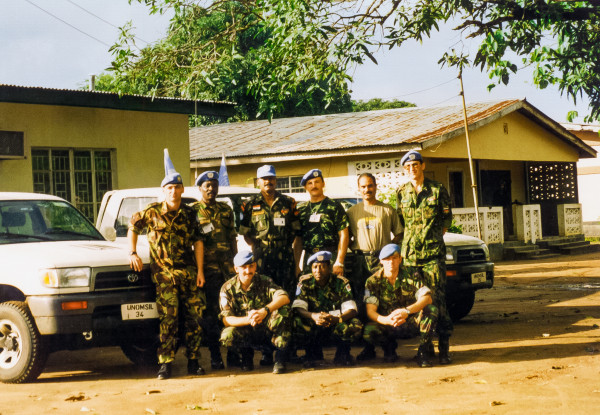Last man out of Freetown: Lieutenant Colonel John Dyer’s experiences in Sierra Leone
Lieutenant Colonel (retired) John Dyer, NZGD, was born in Gisborne and joined the New Zealand Army in 1981. He trained as an officer and served for 20 years. Together with training deployments to Australia, Asia, and the Pacific, he visited operations in Cambodia and Timor-Leste while working for the Chief of Army. In 1998 he deployed to Sierra Leone as a military observer for the United Nations Observer Mission in Sierra Leone (UNOMSIL).

LTCOL John Dyer with his team in Sierra Leone, 1998. Courtesy of LTCOL (retired) John Dyer, NZGD.
The Sierra Leone Civil War began in 1991, when the Revolutionary United Front (RUF) tried to overthrow the government. During the years of conflict that followed thousands of civilians were maimed or killed and the country was rocked by political instability. In February 1998 the Economic Community of West African States Monitoring Group (ECOMOG), led by Nigeria and backed by the African Union, launched an attack on the RUF and forced them to retreat. UNOMSIL was established in June that year and John deployed with Major Steve Pantling in August to join the military observer group lead by Brigadier-General Subhash Joshi from the Indian Army.
In his first role with the mission John worked with a team of nine observers based in a camp four hours’ drive from the capital, Freetown. His team spent almost four months interviewing more than 3,000 former RUF combatants, about 400 of whom were child soldiers. For John this work was confronting but meaningful, because they were able to connect former child soldiers with support. “That was one of the things that tears at you a little bit, but it’s probably one of the most worthwhile things.”
John spent time out in the field investigating incidents, which he and other observers reported to the United Nations. “I remember a couple of times I ended up in hospitals going to visit and see what had happened because there had been a rebel attack on a village. I saw people lying on beds with machete wounds across their backs. The whole trauma of the conflict and attacks against the civilian population, it just makes you realise what people can do to each other.”
“One day we were going through a small village and there were a whole lot of villagers standing around and parading. What had happened is that they had caught a rebel – they had decapitated him and were displaying his head.”
When UNOMSIL was established it was the start of the wet season and the RUF were unable to move from the north of Sierra Leone. However, they spent this time re-arming and mobilised when the wet season ended in November. ECOMOG forces, which had remained in Sierra Leone as the armed protection for civilians and United Nations personnel, folded as the RUF pushed south. The first United Nations personnel to be evacuated travelled in a 10-vehicle convoy to Guinea in December 1998. Major Steve Pantling assisted in the coordination of the first evacuation and travelled to Guinea while John remained in Freetown.
By 5 January, 1999, fewer than 20 United Nations personnel remained in Sierra Leone and on 6 January RUF forces attacked Freetown. John and a senior British officer initiated the evacuation plan that morning.
John and Brigadier-General Joshi had to evacuate United Nations personnel and civilians from Freetown, which became dangerous once ECOMOG personnel became nervous. “There was a strong rumour that the rebels had captured United Nations vehicles, so the ECOMOG forces were thinking, ‘Are these vehicles being driven by the UN or are they being driven by rebels?’”
John and Brigadier-General Joshi collected people from throughout Freetown and took them to a helipad, where they were transported to the airport and flown to Guinea. Four United Nations personnel were trapped in the mission headquarters, which had been cut off. They escaped out the back of the building, climbed over a fence and followed tracks into the hills, where John and Brigadier-General Joshi collected them.
“A couple of times we came to a checkpoint and every weapon that they had was trained on us. At one stage coming out of the hills we came down into an area where there were Nigerians and a whole lot of shooting broke out. To this day I’m not sure who was being targeted.”
John and Brigadier-General Joshi got to the helipad with their last group of evacuees just after 5pm, and the last pick-up at the helipad was 5.30pm. In total John and his team evacuated more than 120 military personnel and civilians. Because the United Nations headquarters was abandoned, more than 20 years later John does not know if any of his team’s work survived.
In 2000 John was awarded the New Zealand Gallantry Decoration for his actions in Freetown on 6 January, 1999. The medal is awarded for acts of exceptional bravery in situations of danger. He left the New Zealand Army in 2001 and was the chief executive of a high-performance sports academy before joining the International Federation of the Red Cross. As an operations and security advisor, he has worked in Switzerland, Indonesia, Timor-Leste, South Sudan, Afghanistan, Pakistan, and Somaliland with the Federation.
“New Zealand peacekeepers and observers have been working overseas for a long time. They have done some great work and will continue to do so. Kiwis have the ability, empathy and emotional intelligence training to be able to relate to what’s going on overseas far better than many others, and I hope we never lose that.”